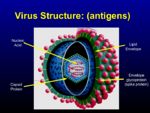Viral Structure
Structure of Viruses
The fundamental component of a virion is the nucleoprotein core that contains the genetic ability to infect host cells and replicate inside them. The genome of viruses able to infect vertebrates is enclosed by a capsid and is haploid in all cases except retroviruses in which they are diploid. The nuclear material and the capsid are called the nucleocapsid. Capsids are made up of multiples of one or more types of protein subunits and it is this orderly arrangement of types of protein that creates a symmetrical structure.
In many virus species the nucleocapsid is covered by an envelope composed of a lipid bilayer and glycoproteins. This envelope is acquired when the nucleocapsid buds through the lipid bilayer of the host cell. In some viruses this envelope is acquired from the endoplasmic reticulum or the golgi apparatus. This represents an important element of virus structure in that the proteins encoded by the viral nucleic acid are integrated into the glycoprotein envelope in the appropriate manner to ensure that the virus has the ability to bind to receptors on host cells. In most enveloped viruses the virus must remain intact to ensure that the virus is infective.
Viruses also have a layer of protein called the "matrix" which is between the nucleocapsid and the envelope. The matrix layer provides the overall virus structure with increased rigidity.
Outside the host cell, viruses exist as particles known as virions, consisting essentially of the virus genome, packaged in a 'capsid,' and a lipid component, which contains proteins that aid entry into the host cell. Viruses can be classified as either:
- Naked- these contain only RNA/DNA and a protein coat
- Enveloped- as well as the RNA/DNA and protein coat, these viruses have a lipid-based membrane
Virus genome: Composed of either RNA or DNA- identification of viruses can be established by testing susceptibility to a ribonuclease or deoxyribonuclease
- Each nucleic acid is either single stranded or double stranded
- Nucleic acids can be either linear (free 3' and 5' ends) or circular (strands are covalently closed)
- Viral genomes can range from 1.7 kilobases (e.g. Porcine circovirus) to over 1200 kilobases (e.g. Mimivirus)
- The genes of some viruses are segmented, coded by two or more nucleic acid fragments, e.g. influenza virus
Viral proteins: Proteins that make up virions are usually structural proteins, used for:
- Protection of the genome
- Attachment to host cell
- Fusion of envelope to host cell membrane
- Non-structural proteins:
- enzymes, e.g. reverse transcriptase
- primers
- transcription factors
Capsids
This is the protein coat that surrounds the genome, and is responsible not only for genome protection but also recognition and attachment to the host cell
- Form symmetrical structures, e.g. helix, icosahedron, rod, cone
Membranes:
- Most viruses have a lipid membrane. If present at the surface, the membrane is known as the 'envelope'. Several viruses keep the lipid membrane within themselves
- Often associated with proteins such as glycoproteins- these often aid the fusion process

